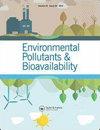Synchronously enhanced biofilm formation and m-dichlorobenzene removal in biotrickling filters by rhamnolipid chelating rare earth elements
IF 3.2
4区 环境科学与生态学
Q2 BIOCHEMISTRY & MOLECULAR BIOLOGY
Environmental Pollutants and Bioavailability
Pub Date : 2022-12-01
DOI:10.1080/26395940.2022.2151516
引用次数: 1
Abstract
ABSTRACT The effects of rhamnolipid chelating La (III) or Nd (III) on m-dichlorobenzene removal and biofilm growth were investigated. The rhamnolipid chelating La (III) or Nd (III) significantly increased the average m-dichlorobenzene elimination capacity by 24% and 29%, respectively, on day 70–130, and the average wet weights of biomass ranged from 11 kg/m3 to 15 kg/m3 in BTFs on day 100–180 at an inlet load of at 47–98 gm3/h and an EBRT of 60s-90s. Microbial community functional genes about biofilm growth and m-dichlorobenzene removal were also increased. In addition, the rhamnolipid chelating La (III) or Nd (III) can improve the membrane permeability, extracellular polymeric substance (EPS) production, catechol 2,3 dioxygenase (C23O) enzyme, and chlorobenzene dioxygenase activity. These results demonstrate that rhamnolipid chelating La (III) or Nd (III) have the potential to improve the performance of BTFs treating hydrophobic and highly toxic VOCs. Graphical Abstract鼠李糖脂螯合稀土元素同步增强生物滴滤膜形成和间二氯苯去除
摘要研究鼠李糖脂螯合La (III)或Nd (III)对间二氯苯去除和生物膜生长的影响。鼠李糖脂螯合物La (III)或Nd (III)在第70-130天显著提高了BTFs对m-二氯苯的平均消除能力,分别提高了24%和29%,在第100-180天,进口负荷为47-98 gm3/h, EBRT为60 -90的条件下,BTFs生物量的平均湿重在11 ~ 15 kg/m3之间。与生物膜生长和间二氯苯去除有关的微生物群落功能基因也有所增加。此外,鼠李糖脂螯合La (III)或Nd (III)可以提高细胞膜通透性、胞外聚合物(EPS)的生成、儿茶酚2,3双加氧酶(C23O)酶和氯苯双加氧酶的活性。这些结果表明,鼠李糖脂螯合La (III)或Nd (III)有可能提高btf处理疏水和高毒性VOCs的性能。图形抽象
本文章由计算机程序翻译,如有差异,请以英文原文为准。
求助全文
约1分钟内获得全文
求助全文
来源期刊

Environmental Pollutants and Bioavailability
Chemical Engineering-Chemical Health and Safety
CiteScore
4.30
自引率
3.00%
发文量
47
审稿时长
13 weeks
期刊介绍:
Environmental Pollutants & Bioavailability is a peer-reviewed open access forum for insights on the chemical aspects of pollutants in the environment and biota, and their impacts on the uptake of the substances by living organisms.
Topics include the occurrence, distribution, transport, transformation, transfer, fate, and effects of environmental pollutants, as well as their impact on living organisms. Substances of interests include heavy metals, persistent organic pollutants, and emerging contaminants, such as engineered nanomaterials, as well as pharmaceuticals and personal-care products as pollutants.
 求助内容:
求助内容: 应助结果提醒方式:
应助结果提醒方式:


